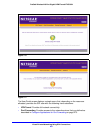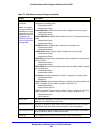
Manage Users, Authentication, and VPN Certificates
295
ProSafe Wireless-N 8-Port Gigabit VPN Firewall FVS318N
Except in the case of IPSec VPN users, when you create a user account, you need to specify
a group. When you create a group, you need to specify a domain.
The following table summarizes the external authentication protocols and methods that the
wireless VPN fire
wall supports.
Table 71. External authentication protocols and methods
Authentication
Protocol or Method
Description
PAP Password Authentication Protocol (PAP) is a simpl
e protocol in which the client sends a
password in clear text.
CHAP Challenge Handshake Authenticatio
n Protocol (CHAP) executes a three-way handshake
in which the client and server trade challenge messages, each responding with a hash of
the other’s challenge message that is calculated using a shared secret value.
RADIUS A network-validated PAP or CHAP password-based authentication method that functions
wi
th Remote Authentication Dial In User Service (RADIUS).
MIAS A network-validated PAP or CHAP password-based authentication method that functions
wi
th Microsoft Internet Authentication Service (MIAS), which is a component of Microsoft
Windows 2003 Server.
WiKID WiKID Systems is a PAP or CHAP key-based two-factor
authentication method that
functions with public key cryptography. The client sends an encrypted PIN to the WiKID
server and receives a one-time passcode with a short expiration period. The client logs in
with the passcode. See Appendix B, Two-Factor Authenticatio
n, for more on WiKID
authentication.
NT Domain A network-validated domain-based au
thentication method that functions with a Microsoft
Windows NT Domain authentication server. This authentication method has been
superseded by Microsoft Active Directory authentication but is supported to authenticate
legacy Windows clients.
Active Directory A network-validated domain-based au
thentication method that functions with a Microsoft
Active Directory authentication server. Microsoft Active Directory authentication servers
support a group and user structure. Because the Active Directory supports a multilevel
hierarchy (for example, groups or organizational units), this information can be queried to
provide specific group policies or bookmarks based on Active Directory attributes.
Note: A Microsoft Active Directory database uses an LDAP organization schema.
LDAP A network-validated domain-ba
sed authentication method that functions with a
Lightweight Directory Access Protocol (LDAP) authentication server. LDAP is a standard
for querying and updating a directory. Because LDAP supports a multilevel hierarchy (for
example, groups or organizational units), this information can be queried to provide
specific group policies or bookmarks based on LDAP attributes.


















